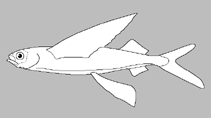Hirundichthys volador (Jordan, 1884)
Atlantic blackwing flyingfish
Add your observation in Fish Watcher
| Native range | All suitable habitat | Point map | Year 2050 |

|
| This map was computer-generated and has not yet been reviewed. |
| Hirundichthys volador AquaMaps Data sources: GBIF OBIS |
Upload your photos and videos
Google imageNo image available for this species;
drawing shows typical species in Exocoetidae.
Google imageNo image available for this species;
drawing shows typical species in Exocoetidae.
Classification / Names Common names | Synonyms | Catalog of Fishes(genus, species) | ITIS | CoL | WoRMS | Cloffa
Teleostei (teleosts) > Beloniformes (Needle fishes) > Exocoetidae (Flyingfishes)
Etymology: Hirundichthys: latin, hirundo = swift; 1300 + Greek, ichthys = fish (Ref. 45335).
Etymology: Hirundichthys: latin, hirundo = swift; 1300 + Greek, ichthys = fish (Ref. 45335).
Environment: milieu / climate zone / depth range / distribution range Ecology
Marine; pelagic-oceanic; depth range 0 - ? m. Subtropical
Distribution Countries | FAO areas | Ecosystems | Occurrences | Point map | Introductions | Faunafri
Atlantic Ocean. NW Atlantic (Massachussetts south along the US) Bermuda, the Bahamas ad throughout the Gulf of Mexico and the Caribbean Sea. East of 30° W are extremely rare and could possibly represent strays of H. rondeletti. Confirmed to occur in Portugal, the Azores and Canary Islands.
Size / Weight / Age
Short description Identification keys | Morphology | Morphometrics
Dorsal soft rays (total): 10 - 13; Anal soft rays: 10 - 13; Vertebrae: 44 - 47. This species is distinguished by the following characters: elongated body nearly rectangular in cross-section, almost flat ventrally; its depth 5.2-6.4 times in standard length (SL): vertebrae 44-47; predorsal scales 25-31; scales in transverse row 6.5 to 8.5, usually 7.5; head 4.2-5.2 times in SL;
eye 3.1-3.3 times in head; jaws subequal, the teeth conspicuous, conical; no palatine teeth; gill rakers on first arch 24-29; low dorsal fin with 10-13 rays; anal fin with 10-13 rays, originating
slightly before, or 1 to 2 rays behind dorsal-fin origin; pectoral fins 1.2-1.4 times in SL, with 16-19 rays and the first two rays unbranched; pelvic fins 2.5-3.4 times in SL, inserted slightly nearer to posterior margin of opercle than origin of caudal-fin base; juveniles are not barbelled; colour of body dark above, pale below, the dorsal and caudal fins greyish and anal fin transparent; pectoral fins black without unpigmented cross-band and with a narrow light outer margin; pelvic fins usually with black spot. Juveniles less than 5,0 cm SL have a few dark transverse vertical bands on body; dorsal, pectoral and pelvic fins mottled with dark spots and bands (Ref. 109257)..
Feeds on zooplankton. Eggs demersal. No importance to fisheries (Ref. 109257)..
Life cycle and mating behavior Maturity | Reproduction | Spawning | Eggs | Fecundity | Larvae
Main reference
Upload your references | References | Coordinator : Parin, Nikolay V. | Collaborators
Carpenter, K.E. and N. De Angelis (eds.), 2016. The living marine resources of the Eastern Central Atlantic. Vol. 3: Bony fishes part 1 (Elopiformes to Scorpaeniformes). FAO Species Identification Guide for Fishery Purposes, Rome, FAO. pp. 1511-2350. (Ref. 109257)
IUCN Red List Status (Ref. 130435: Version 2024-2)
Least Concern (LC) ; Date assessed: 28 January 2013
CITES
Not Evaluated
Threat to humans
Harmless
Human uses
Fisheries: of no interest
FAO - Publication: search | FishSource |
More information
Trophic ecology
Food items
Diet composition
Food consumption
Food rations
Predators
Food items
Diet composition
Food consumption
Food rations
Predators
Ecology
Ecology
Ecology
Population dynamics
Growth parameters
Max. ages / sizes
Length-weight rel.
Length-length rel.
Length-frequencies
Mass conversion
Recruitment
Abundance
Growth parameters
Max. ages / sizes
Length-weight rel.
Length-length rel.
Length-frequencies
Mass conversion
Recruitment
Abundance
Life cycle
Reproduction
Maturity
Maturity/Gills rel.
Fecundity
Spawning
Spawning aggregations
Eggs
Egg development
Larvae
Larval dynamics
Reproduction
Maturity
Maturity/Gills rel.
Fecundity
Spawning
Spawning aggregations
Eggs
Egg development
Larvae
Larval dynamics
Anatomy
Gill area
Brain
Otolith
Gill area
Brain
Otolith
Physiology
Body composition
Nutrients
Oxygen consumption
Swimming type
Swimming speed
Visual pigments
Fish sound
Diseases & Parasites
Toxicity (LC50s)
Body composition
Nutrients
Oxygen consumption
Swimming type
Swimming speed
Visual pigments
Fish sound
Diseases & Parasites
Toxicity (LC50s)
Genetics
Genetics
Heterozygosity
Heritability
Genetics
Heterozygosity
Heritability
Human related
Aquaculture systems
Aquaculture profiles
Strains
Ciguatera cases
Stamps, coins, misc.
Aquaculture systems
Aquaculture profiles
Strains
Ciguatera cases
Stamps, coins, misc.
Tools
E-book | Field guide | Length-frequency wizard | Life-history tool | Point map | Classification Tree
| Catch-MSY |
Special reports
Download XML
Internet sources
AFORO (otoliths) | Aquatic Commons | BHL | Cloffa | BOLDSystems | Websites from users | Check FishWatcher | CISTI | Catalog of Fishes: genus, species | DiscoverLife | ECOTOX | FAO - Publication: search | Faunafri | Fishipedia | Fishtrace | GenBank: genome, nucleotide | GloBI | Google Books | Google Scholar | Google | IGFA World Record | MitoFish | National databases | Otolith Atlas of Taiwan Fishes | PubMed | Reef Life Survey | Socotra Atlas | Tree of Life | Wikipedia: Go, Search | World Records Freshwater Fishing | Zoological Record
Estimates based on models
Phylogenetic diversity index (Ref. 82804): PD50 = 0.5002 [Uniqueness, from 0.5 = low to 2.0 = high].
Bayesian length-weight: a=0.00631 (0.00288 - 0.01384), b=3.05 (2.85 - 3.25), in cm total length, based on LWR estimates for this (Sub)family-body shape (Ref. 93245).
Trophic level (Ref. 69278): 3.0 ±0.1 se; based on size and trophs of closest relatives
Resilience (Ref. 120179): High, minimum population doubling time less than 15 months (Preliminary K or Fecundity.).
Fishing Vulnerability (Ref. 59153): Low vulnerability (19 of 100).




